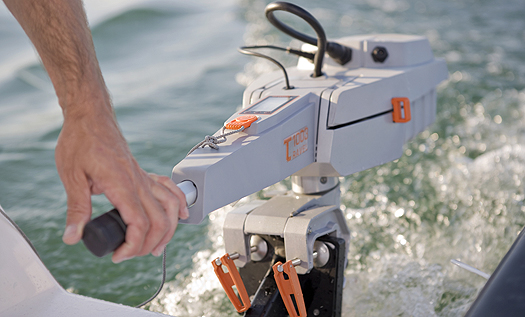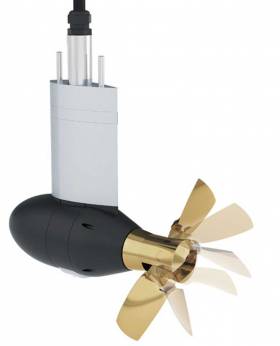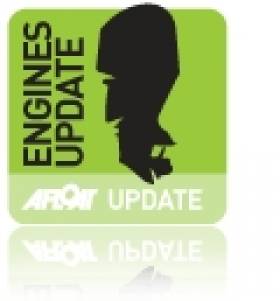Displaying items by tag: Torqueedo
Yamaha Motor Takes Over Electric Propulsion Specialists Torqueedo
Electric boat engine specialists Torqueedo are now under the Yamaha Motor umbrella, as Marine Industry News reports.
The deal with German company DEUTZ AG to acquire all of Torqueedo’s shares now positions the Japanese giant to become a market leader in electric propulsion — as well as assist its efforts to achieve carbon neutrality in the marine industry.
Torqueedo was founded in Germany in 2005 as a response to strict regulations on the use of internal combustion engines on Lake Starnberg in Bavaria.
It recently updated its original range of electric outboard motors, adding to a range that features inboard propulsion systems, batteries and more, as well as a significant R&D division with various patents in electromobility.
Marine Industry News has more on the story HERE.
The new electric-first Delphia 10 Lounge enjoyed its official launch at boot Düsseldorf on Sunday morning (22 January).
Similar to the D10 LoungeTop which was unveiled last November by the ‘mindful cruising’ brand, the Delphia 10 Lounge boasts an open cockpit with up to 12 seating positions so even more can get together for fun and relaxing times.
While the focus is on short retreats along city canals and other inland waterways, weather conditions can still change quickly — which prompted the design of a complete cockpit enclosure protect those on board from the elements.
 Evening trips on the Delphia 10 Lounge can go a little further thanks to multiple accommodation options below deck
Evening trips on the Delphia 10 Lounge can go a little further thanks to multiple accommodation options below deck
And down below, the spacious interior with up to four sleeping berths and a bathroom is the perfect set-up for a night onboard when the evening trip goes a little further.
In the propulsion department, once again Delphia has partnered with marine e-mobility specialists Torqueedo to equip the Delphia 10 Lounge with an 80hp Deep Blue electric motor, offering three different configurations of electric propulsion. And like the LoungeTop, it also comes with a diesel option with reduced-emission engines from Yanmar.
Express your interest in the Delphia 10 Lounge with recently appointed Irish agents MGM Boats at [email protected] — and meet them this week at boot Düsseldorf to see more the boat at Hall 1, Stand B/16.
Delphia’s New D10 LoungeTop Cruiser Promises Comfort, Style and Innovation
The latest addition to Delphia’s ‘mindful cruising’ range — available in Ireland via MGM Boats in Dun Laoghaire — is the Delphia 10 LoungeTop, which will have its worldwide launch in Berlin this week.
Designed for relaxation in total comfort, the Delphia 10 LoungeTop has a refined silhouette with an “innovative” outside cover that encompasses the best aspects of open and enclosed boating.
Combined with an optimised layout and its electric-power-first spec, the Delphia 10 LoungeTop is “the ultimate partner to go mindfully cruising through the canals and along the coast”.
 The rear platform’s bike storage solution makes it easy to get out and explore the landscape along your travels
The rear platform’s bike storage solution makes it easy to get out and explore the landscape along your travels
Moving around inside and outside has never been easier thanks to the one single-level platform and open cockpit, while the deep side decks and the closing companionway create a secured environment.
Disembarking for explorations is facilitated by the side gate on starboard. In particular, the rear platform’s bike storage solution makes it easy to get out and explore the landscape along your travels.
Staying on board, two protected lounge areas in the open cockpit offer up to 12 seating places. A wet bar to prepare meals and a variable dining bench on port complete a superb environment for socialising and relaxing.
Sustainable fabrics and materials as well as choice of two woodwork and floor options for the interior guarantee a pleasant environment.
 The Delphia 10 LoungeTop boats an “innovative” outside cover that encompasses the best aspects of open and enclosed boating on deck
The Delphia 10 LoungeTop boats an “innovative” outside cover that encompasses the best aspects of open and enclosed boating on deck
In the single or twin cabins, natural light comes though the large portholes reinforcing this relaxing feeling and guaranteeing bright days and optimal conditions for peace of mind.
Finally, a contemporary bathroom with walk-in shower will help you unwind after a day of adventure.
Proud of its ‘nature friendly’ reputation, Delphia teamed up with Torqeedo, a leader in e-mobility in the marine industry, to fit the Delphia 10 LoungeTop with the powerful 80hp Deep Blue electric motor, offering three different configurations of electric propulsion. It also comes with a diesel option with reduced-emission engines from Yanmar.
The worldwide launch of the latest Delphia 10 will happen at the Boat & Fun exhibition in Berlin from this Thursday 24 to Sunday 27 November. Express your interest with recently appointed Irish agents MGM Boats at [email protected].
‘Mindful Cruising’ With the Delphia Range From MGM Boats
‘Mindful cruising’ is the philosophy behind the sustainable boating brand Delphia, available from recently appointed Irish dealer MGM Boats in Dun Laoghaire.
This concept has grown out of 30 years of custom-designed boats inspired by nature, characterised by a more comfortable and relaxed approach to cruising inland waterways and the use of smart solutions and sustainable materials.
And in its latest iteration, with the Delphia 11, electric propulsion makes for results even more in tune with the environment.
In its ambition to be a “nature-friendly” boatbuilder, the Polish brand teamed up with Torqeedo, a leader in e-mobility in the marine industry, to equip its vessels with the Dutch company’s user-friendly and widely serviceable Deep Blue electric drive system.
The Delphia 11 comes in electric and diesel versions — in an elegant Sedan or luxurious FlyLounge layout — and among its many remarkable features is its purposely designed solar power (photovoltaic) system, which means you can extend your stay in a secluded area without having to worry about visiting a marina to recharge your batteries.
Meanwhile, the diesel-powered Delphia 12 also comes in Sedan and FlyLounge versions, with key features including its low-noise operation, its easy manoeuvring thanks to powerful thrusters and a shallow draft with a 100% displacement hull specially designed by Tony Castro for navigating inland waterways.
For more details, get in touch with MGM Boats via their Facebook page and download the Delphia press kit below.
MGM Boats will have a busy post-summer with both the Cannes Boat show from 6-11 September and the Southampton International Boat Show from 16-25 September.
Torqeedo wins Pittman Award for Pod Motors & Rudder Drive
Torqeedo, the global leader in the fast-growing electric propulsion industry, has been honoured with a fourth Pittman Innovation Award by SAIL Magazine, for its Cruise Fixed Pod motor series and the ground-breaking Rudder Drive. In Ireland, Torqueedo is distributed by Union Chandlery in Cork.
Working with Hanse Yachts and rudder builder Jefa Marine, Torqeedo adapted its 8 HP equivalent Cruise 4.0 FP with folding propeller to allow its integration into the rudder blade of the new Hanse 315 e-motion. Weighing 200 lbs less than a comparable diesel engine, the Rudder Drive is emission-free and almost silent. It offers regenerative power while under sail, delivering unmatched manoeuvrability, due to the 100 degrees of rudder travel, eliminating the need for bow and/or stern thrusters.
This is the second major industry recognition for Torqeedo’s alternative to a saildrive, in three months. The Cruise FP system was named Overall Winner at the DAME Awards 2016, at METSTRADE Show in Amsterdam.
Christoph Ballin, co-founder and CEO of Torqeedo, comments, “We are honoured to receive this award. Torqeedo has a strong relationship with sailors the world over. It's a market segment that not only appreciates the technology, but understands and respects our commitment to the environment.”
It is not the first time Torqeedo receives the Pittman Innovation Award, named after a long-time technical editor of US-based SAIL magazine. In 2016, the company was recognised for its Deep Blue Hybrid system. It also won in 2012 for its Cruise 2.0/4.0 and in 2007 for its Travel 801 outboard. Last year, the company won the Most Eco-Friendly Marine Business of 2016 at the 21st China International Boat Show in Shanghai.
Torqeedo Owner's Revolt Against the Petrol Outboard Engine
#electricoutboard – Torqeedo owner Jack O'Keefe from Cork Harbour tells of his sailing adventures in a Drascombe Coaster and how after swapping from a petrol version the rewards from his new electric outboard engine are less noise, no smells, more stowage, better sailing performance and a motor that can be started by a small child. But it's still not silent, there's a whine...!
The thinking behind it...
My Drascombe is a Coaster, which has a small cabin with two berths. Drascombes are normally used as motorsailers and are rarely to be seen afloat without an outboard hanging in the well at the transom. The concept of sailing without dependence on an outboard motor and all that goes with it. viz. Carrying petrol, unreliability and the difficulty of starting, has been in my mind for a few years. I had a very reliable petrol 8hp outboard that my wife never had the strength of arm to start, and in event of capsize would keep the Coaster swamped due to its weight. After a couple of seasons minimising the use of the outboard – a promised tax refund was the final push to go electric. I saw in the Torqueedo promo videos how their motor is very light and unaffected by immersion. The use of Lithium Ion batteries and the option of a remote throttle were also strong factors in selecting the Torqueedo model over others.

Torqeedo's Travel 1003L – ease of starting the motor is a plus
I selected the Travel 1003L model on advice from the makers at the London Boat Show. I looked to purchasing on the internet but decided to buy from Union Chandlery on the basis that I might need support. The first use of the motor was in Morbihan Gulf and after being used in anger going through one of the tidal gates – the motor stopped and did not start again for the week. Union chandlery sent it back.– the manufacturers replaced it and when the original one got back to their workshop they found that heavy fishing line was caught invisibly inside the prop.
Outcome
I have now completed my third season with my electric motor. Since I fitted it and learned how to use it I got rid of the petrol outboard altogether. The big question with the electric motor is range, there is no doubt that I do more sailing – tacking in narrow channels and that I pay more attention to timing with regard to tide on passages. In the period of use I have on one occasion depended on a tow - after 26nm on the French canals and having passed the sea lock missing the last of the ebb while socialising in a raft up.
I have learned to appreciate the ease of starting the motor – place the magnetic key, turn the throttle and it runs – no pulling cords or twiddling choke. The stowage space created by not having a petrol can nor funnel, oil, spare plugs etc. is another unexpected boon. The other unexpected advantage is the sailing performance of the boat is greatly improved by not having a large mass of metal hanging on the stern. A charge costs less than a unit half a unit and is usually blagged from a pub or neighbour. A night in a marina means a chance to charge up all batteries and reserves.
Monitoring
The batteries come with built in GPS and electronics to calculate the distance left within the current charge. This is a useful tool to keep discipline and help to stretch the charge as long as possible. This adds to the cost of the batteries and I imagine the system could have been made part of the motor assembly rather than having to pay for a GPS and computer for each battery.
Lead Battery backup
The battery for the motor is 29.6 volt 520 WHr equivalent to a 43 AHr lead acid battery. Since the charge voltage for the battery is 12v a lead acid battery can be used to recharge the motor battery. I have made a jumper cable using a Maplin HH62S DC power plug with a 5A fuse in the cable so that the Li Ion battery can be charged up on board from a 50 AHr backup lead acid battery or the boat's main battery via the cigarette lighter socket. This option makes a big difference during longer cruises away from mains supplies – effectively giving another spare battery. Of course it also means the battery can be charged from the car while towing.
Solar
Charging is limited to 4A therefore at 12 v a 36w - 40w solar panel capacity is the correct size. This must be controlled to 12v – a complete charge taking in the order of 10 hours sunlight – so this solution is only applicable when the boat is moored up between voyages. I tend to use the solar panels to keep the lead acid batteries charged as they are more tolerant to fluctuations in voltage from the panels.
Living with electric
Using an electric motor for small boat cruising means you manage your cruise to suit the tides and be efficient. The rewards are less noise, no smells, more stowage, better sailing performance and a motor that can be started by a small child. I did expect the motor to be silent – in fact there is a clear electric whine with which one can easily tolerate. If you enjoy sailing, using an electric motor for day sailing is a "no-brainer" especially if you have a spare battery – and it helps if you are a green crank. A surprising disadvantage is that the noise and smoke from neighbouring outboards becomes exasperatingly exacerbated.
The electric motor provides all the power needed to get into and out of tight berths, or up sheltered channels. I have needed it once in emergency to get me clear of a lee shore at the Kedge in West Cork, but mostly it is run in calms and to get back to the moorings under the trees a mile upriver from Crosshaven. For me the electric motor is a step short of the goal of no motor – and with my experience so far I believe there is no need to go that far!
































































